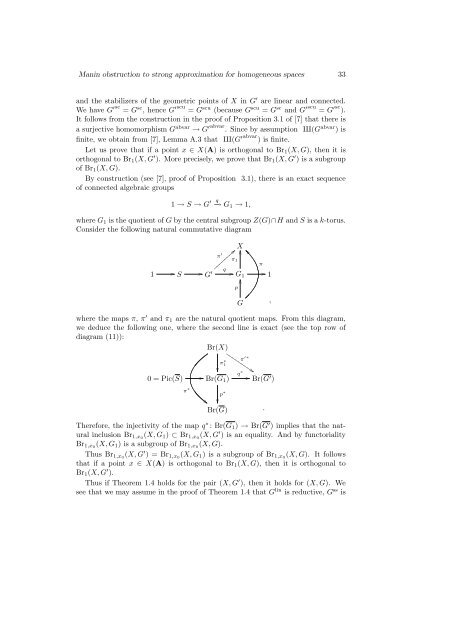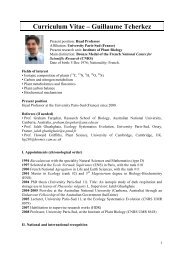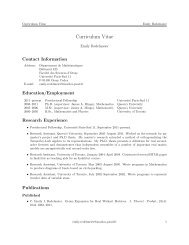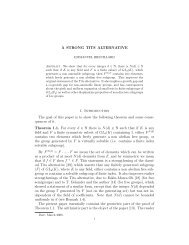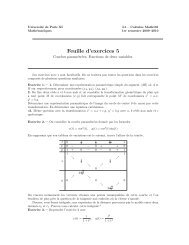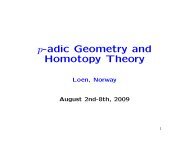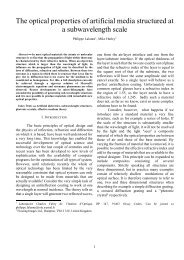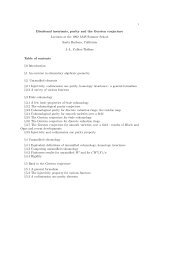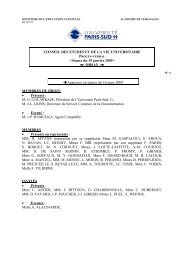Manin obstruction to strong approximation for homogeneous spaces
Manin obstruction to strong approximation for homogeneous spaces
Manin obstruction to strong approximation for homogeneous spaces
You also want an ePaper? Increase the reach of your titles
YUMPU automatically turns print PDFs into web optimized ePapers that Google loves.
<<strong>strong</strong>>Manin</<strong>strong</strong>> <<strong>strong</strong>>obstruction</<strong>strong</strong>> <<strong>strong</strong>>to</<strong>strong</strong>> <strong>strong</strong> <strong>approximation</strong> <strong>for</strong> <strong>homogeneous</strong> <strong>spaces</strong> 33and the stabilizers of the geometric points of X in G ′ are linear and connected.We have G ′ sc = G sc , hence G ′ scu = G scu (because G scu = G sc and G ′ scu = G ′ sc ).It follows from the construction in the proof of Proposition 3.1 of [7] that there isa surjective homomorphism G abvar → G ′ abvar . Since by assumption X(G abvar ) isfinite, we obtain from [7], Lemma A.3 that X(G ′ abvar ) is finite.Let us prove that if a point x ∈ X(A) is orthogonal <<strong>strong</strong>>to</<strong>strong</strong>> Br 1 (X, G), then it isorthogonal <<strong>strong</strong>>to</<strong>strong</strong>> Br 1 (X, G ′ ). More precisely, we prove that Br 1 (X, G ′ ) is a subgroupof Br 1 (X, G).By construction (see [7], proof of Proposition 3.1), there is an exact sequenceof connected algebraic groups1 → S → G ′ q−→ G1 → 1,where G 1 is the quotient of G by the central subgroup Z(G)∩H and S is a k-<<strong>strong</strong>>to</<strong>strong</strong>>rus.Consider the following natural commutative diagram Xπ ′ π 1π1 S qG ′ G 1 1where the maps π, π ′ and π 1 are the natural quotient maps. From this diagram,we deduce the following one, where the second line is exact (see the <<strong>strong</strong>>to</<strong>strong</strong>>p row ofdiagram (11)):Br(X) π ∗π ∗ 10 = Pic(S) Br(G 1 )p ∗pGπ ′∗,q ∗ Br(G ′ )Br(G) .There<strong>for</strong>e, the injectivity of the map q ∗ : Br(G 1 ) → Br(G ′ ) implies that the naturalinclusion Br 1,x0 (X, G 1 ) ⊂ Br 1,x0 (X, G ′ ) is an equality. And by func<<strong>strong</strong>>to</<strong>strong</strong>>rialityBr 1,x0 (X, G 1 ) is a subgroup of Br 1,x0 (X, G).Thus Br 1,x0 (X, G ′ ) = Br 1,x0 (X, G 1 ) is a subgroup of Br 1,x0 (X, G). It followsthat if a point x ∈ X(A) is orthogonal <<strong>strong</strong>>to</<strong>strong</strong>> Br 1 (X, G), then it is orthogonal <<strong>strong</strong>>to</<strong>strong</strong>>Br 1 (X, G ′ ).Thus if Theorem 1.4 holds <strong>for</strong> the pair (X, G ′ ), then it holds <strong>for</strong> (X, G). Wesee that we may assume in the proof of Theorem 1.4 that G lin is reductive, G ss is


